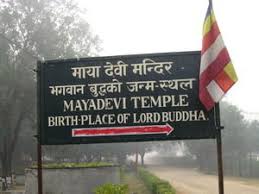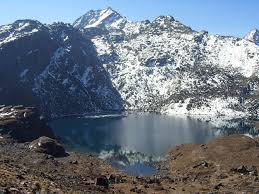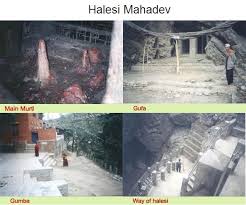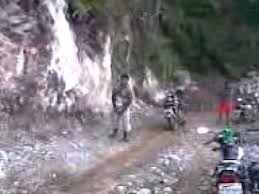skip to main |
skip to sidebar

5:15 AM

Niraj Luitel
 No comments
No comments
Swargadwari is a hilltop temple complex and pilgrimage site in Pyuthan District, Nepal commemorating the special role of cows in Hinduism. It is said to have been founded by one Guru Maharaj who spent most of his life in the vicinity herding and milking thousands of cows. According to traditional stories, some of his devotees followed him to see where he took the cows, but they never could find him.
 Before he left physical body the Guru gave some of his powers to a few disciples. On the day he departed his physical body by his own wish, a number of people gathered around him at the place where he habitually meditated. The Guru left his body after bidding goodbye to his disciples and other followers. His favourite cow also died at the same instant, then the rest of the cows miraculously disappeared within a few days. There are also accounts of cows emptying their milk by themselves every day at the same time, at the place where the Guru died.
Swargadwari is counted among Nepal's top pilgrimage sites and is listed in a national inventory of cultural and historic heritage sites.
As of 2009, a cable car to the temple complex was under construction. In the aftermath of the 1996-2006 Nepalese Civil War, donations of straw and hay had diminished to a point where resident cattle at Swargawari were in danger of starving.
Before he left physical body the Guru gave some of his powers to a few disciples. On the day he departed his physical body by his own wish, a number of people gathered around him at the place where he habitually meditated. The Guru left his body after bidding goodbye to his disciples and other followers. His favourite cow also died at the same instant, then the rest of the cows miraculously disappeared within a few days. There are also accounts of cows emptying their milk by themselves every day at the same time, at the place where the Guru died.
Swargadwari is counted among Nepal's top pilgrimage sites and is listed in a national inventory of cultural and historic heritage sites.
As of 2009, a cable car to the temple complex was under construction. In the aftermath of the 1996-2006 Nepalese Civil War, donations of straw and hay had diminished to a point where resident cattle at Swargawari were in danger of starving.

5:14 AM

Niraj Luitel
 2 comments
2 comments
Maya Devi Temple is a Hindu temple dedicated to goddess Maya in the holy city of Haridwar of Uttarakhand state in India. It is believed that the heart and navel of goddess Sati fell in the region where the temple stands today and thus it is sometimes referred to as a Shakti Peetha.
 Goddess Maya is the Adhisthatri deity of Haridwar. She is a three-headed and four-armed deity who is believed to be an incarnation of Shakti. Haridwar was previously known as Mayapuri in reverence to this deity. The temple is a Siddh Peetha which are the places of worship where desires get fulfilled. It is one of three such Peethas located in Haridwar, the other two being Chandi Devi Temple and Mansa Devi Temple.
Goddess Maya is the Adhisthatri deity of Haridwar. She is a three-headed and four-armed deity who is believed to be an incarnation of Shakti. Haridwar was previously known as Mayapuri in reverence to this deity. The temple is a Siddh Peetha which are the places of worship where desires get fulfilled. It is one of three such Peethas located in Haridwar, the other two being Chandi Devi Temple and Mansa Devi Temple.
Description
The temple dates back to the eleventh century. It is one of the three ancient temples of Haridwar which are still intact, the other two being Narayana-shila and Bhairava Temple. The inner shrine consists of murtis (icons) of goddesses Maya in the centre, Kali on the left, Kamakhya on the right. There are also two other goddesses who are also forms of Shakti, present in the inner shrine. The temple is located to the east of Har ki Pauri and is easily accessible by buses and auto rickshaws. It is regarded as a must visit for devotees going to Haridwar. The temple is visited by many devotees from various parts of the country especially during the Navratra and the Kumbha Mela in Haridwar.

5:12 AM

Niraj Luitel
 No comments
No comments
Muktinath is a sacred place both for Hindus and Buddhists located in Muktinath Valley at an altitude of 3,710 meters at the foot of the Thorong La mountain pass (part of the Himalayas), Mustang district, Nepal. The site is close to the village of Ranipauwa, which sometimes mistakenly is called Muktinath as well.
 The Hindus call the sacred place Mukti Kshetra, which literally means the "place of salvation". Mainly the temple is with a predominant Sri Vaishnava origin and worshipped by Buddhists. This temple is considered to be the 105th among the available 108 Divya Desam. The ancient name of this place, before Buddhist origin is known as Thiru Saligramam.
This houses the Saligrama sila considered to be the naturally available form of Sriman Maryanna - the Hindu God HEAD. It is also one of the 51 Sakthi peetams.The Buddhists call it Chumig Gyatsa, which in Tibetan means 'Hundred Waters'. For Tibetan Buddhists, Muktinath-Chumig Gyatsa is a very important place of Dakinis, goddesses known as Sky Dancers and one of the 24 Tantric places. They understand the murti to be a manifestation of Avalokitesvara.
The Hindus call the sacred place Mukti Kshetra, which literally means the "place of salvation". Mainly the temple is with a predominant Sri Vaishnava origin and worshipped by Buddhists. This temple is considered to be the 105th among the available 108 Divya Desam. The ancient name of this place, before Buddhist origin is known as Thiru Saligramam.
This houses the Saligrama sila considered to be the naturally available form of Sriman Maryanna - the Hindu God HEAD. It is also one of the 51 Sakthi peetams.The Buddhists call it Chumig Gyatsa, which in Tibetan means 'Hundred Waters'. For Tibetan Buddhists, Muktinath-Chumig Gyatsa is a very important place of Dakinis, goddesses known as Sky Dancers and one of the 24 Tantric places. They understand the murti to be a manifestation of Avalokitesvara.

5:08 AM

Niraj Luitel
 No comments
No comments
Manakamana is the name of a Hindu Goddess. It is believed that the Goddess fulfils the wishes of the people. The term ‘mana’ means the ‘heart’ or ‘soul’ and ‘kamana’ means the ‘wish’.
The most popular temple of Manakamana is in Gorkha. The others are in various places like manakamana. It is said that a King of Gorkha was blessed by the goddess to get victory over small kingdoms and make a big Gorkha. Manakamana of gorkha is a popular place for a specific fair called Panchami. The temple was initially inaccessible and one had to ride on horseback for 2–3 days. Now it is easily accessible by Cable Car.
History
The queen of Ram Shah, the king of Gorkha, born in 1614 AD, was a goddess known only to her devotee, Lakhan Thapa. One day the king saw his queen in the form of a goddess. He told about it to Lakhan Thapa and he died instantly, in 1636 AD. The queen committed Sati (commit cremation with the husband's pyre as per custom of that time). Lakhan Thapa lamented on her Sati.The queen consoled her devotee by telling him that she would reappear again. Six months later, a farmer hit a stone while ploughing his field. Blood and milk came out from the stone.
 When news about this spread to Lakhan Thapa, he realized that his had come true. came to know the news. He worshipped the place with 'tantric' rituals and the flow of blood and milk ceased. The ruling king of Gorkha, upon learning about the incident, donated land and money and the site became the foundation of the present-day shrine- Manakamana Temple. The current pujari, Priest, is the 17th generation descendant of Lakhan Thapa.
The Shrine of Manakamana renovated many times over centuries has four story pagoda style roofs with entrance from the South-West. The Pujari performs daily prayers and ritual in the temple behind closed doors by offering eggs, oranges, rice, red powder and strips of cloth to the deities. The people can then make their offerings after the Pujari.
When news about this spread to Lakhan Thapa, he realized that his had come true. came to know the news. He worshipped the place with 'tantric' rituals and the flow of blood and milk ceased. The ruling king of Gorkha, upon learning about the incident, donated land and money and the site became the foundation of the present-day shrine- Manakamana Temple. The current pujari, Priest, is the 17th generation descendant of Lakhan Thapa.
The Shrine of Manakamana renovated many times over centuries has four story pagoda style roofs with entrance from the South-West. The Pujari performs daily prayers and ritual in the temple behind closed doors by offering eggs, oranges, rice, red powder and strips of cloth to the deities. The people can then make their offerings after the Pujari.

5:07 AM

Niraj Luitel
 No comments
No comments
Gosaikunda is an alpine freshwater oligotrophic lake in Nepal's Langtang National Park, located at an altitude of 4,380 m (14,370 ft) above sea level in the Rasuwa District with a surface of 13.8 ha (34 acres). Together with associated lakes, the Gosaikunda Lake complex is 1,030 ha (4.0 sq mi) in size and has been designated a Ramsar site in September 2007.
 The lake melts and sips down to form the Trishuli river and remains frozen for six months in winter October to June. There are 108 lakes in this area, small to medium in size. The challenging Lauribina La pass at an altitude of 4,610 m (15,120 ft) is on its outskirts.
The lake melts and sips down to form the Trishuli river and remains frozen for six months in winter October to June. There are 108 lakes in this area, small to medium in size. The challenging Lauribina La pass at an altitude of 4,610 m (15,120 ft) is on its outskirts.
Trekking to Gosaikunda
 The popular start to the trek to Gosaikunda are in Dhunche Village or Syabru Besi both from the Langtang side. Alternatively, trekkers may also start from Sundarijal, which lies on the outskirts of Kathmandu.
If you are starting from Dhunche, the first day involves a long steady climb to reach Chandan Bari, which is at a height of about 3200 meters. On the second day, one reaches Laurebinayak at about 3700 metres. At this point, some trekkers choose to climb ahead to Gosaikund, though altitude sickness is a concern due to rapid ascent. Many trekkers choose to stay at Laurebinayak which also provides excellent sunset and sunrise views of the Langtang and Ganesh Himal.
The popular start to the trek to Gosaikunda are in Dhunche Village or Syabru Besi both from the Langtang side. Alternatively, trekkers may also start from Sundarijal, which lies on the outskirts of Kathmandu.
If you are starting from Dhunche, the first day involves a long steady climb to reach Chandan Bari, which is at a height of about 3200 meters. On the second day, one reaches Laurebinayak at about 3700 metres. At this point, some trekkers choose to climb ahead to Gosaikund, though altitude sickness is a concern due to rapid ascent. Many trekkers choose to stay at Laurebinayak which also provides excellent sunset and sunrise views of the Langtang and Ganesh Himal.
 The descent from Gosaikund to Sundarijal takes about four days. The first day involves a short climb to Laurebina pass (4600 metres) and a rapid descent to Phedi or Teashop. Depending on pace, there are options to stay at Tharepati, Mangengoth, Kutumsang and afterwards at many village habitations every two hours. Accommodation is quite easily available, though basic and a variety of food options are also available at tea house stops.
The trails are very well marked, except between Ghopte and Thorepati, where chances of losing ones way are real.
The descent from Gosaikund to Sundarijal takes about four days. The first day involves a short climb to Laurebina pass (4600 metres) and a rapid descent to Phedi or Teashop. Depending on pace, there are options to stay at Tharepati, Mangengoth, Kutumsang and afterwards at many village habitations every two hours. Accommodation is quite easily available, though basic and a variety of food options are also available at tea house stops.
The trails are very well marked, except between Ghopte and Thorepati, where chances of losing ones way are real.

1:05 AM

Niraj Luitel
 No comments
No comments
Among the most ancient and holiest places of Nepal, it is very popular as The Pashupatinath of the eastern Nepal. It is situated at the hilly region of the country in between the holy rivers Dudh Koshi to the right and Sunkoshi to the left. The temple is situated at the top of a small hill inside a beautiful cave. There lie other numerous small beautiful caves too. Importance. Here, the image of the god is inside the cave, which is full of natural beauty. Inside the cave is dark and there are bats flying here and there. It is also a kind of pride for the people living there, as it is as famous as other temples like the Pashupatinath, the Lumbini etc. even internationally. It is the natural cave, which lies in 4th remote hilly region and is believed to be in existence since 6000 years. It is the place full of natural beauty and cultural inheritance. It is popular among the Hindus as well as the Buddhists all over the world.
Mythology

 There are three mysterious caves, which are believed to be the three eyes of lord Shiva. as we see in the first cave, we see an image of lord Shiva which is called as Haleshwar Mahadev. In the second cave there is an image of Nandi.
Haleshi temple is situated in the Khotang district of eastern Nepal . This is a small hilly area full of natural beauty. The location of the place itself is beautiful. One the other hand, the beautiful and mysterious natural caves; full of different natural images, look as if the stone carving artist have donelt carefully taking a lot of time. Here, the images are all inside the caves which themselves are mysterious.
There are three mysterious caves, which are believed to be the three eyes of lord Shiva. as we see in the first cave, we see an image of lord Shiva which is called as Haleshwar Mahadev. In the second cave there is an image of Nandi.
Haleshi temple is situated in the Khotang district of eastern Nepal . This is a small hilly area full of natural beauty. The location of the place itself is beautiful. One the other hand, the beautiful and mysterious natural caves; full of different natural images, look as if the stone carving artist have donelt carefully taking a lot of time. Here, the images are all inside the caves which themselves are mysterious.
Worship & Festivals
Lord Vishnu was the first ever devotee to pay homage to the Haleshi Mahadeva in the Satya Yuga, the golden age where as Balaram did in the third age called Dwapar Yuga. Afterwards, many kings, sages, devotees, philosophers, thinkers, hermits, abbots, ascetics and shankaracharya have been paying homage to this sacred place.
 During the homage hours, kettledrum, cymbal, clarinet etc, there is a custom of performing special ceremonial rites of the Haleshor Mahadeva during some festivals such as Bala Chaturdashi, Shiva Ratri, Ram Nawami and Teez etc. In between, devotees perform various other religious performances like fire sacrifice and recitals of the Rudri, the Chandi and the Vedas, our religious epics, burning of 10 millions holy threads and offering millions of wood apple leaves etc. The Haleshwor Mahadeva is taken as the god of fulfilling wishes and giving boons to the real devotees. So devotees vow solemnly and act accordingly as their wishes has been fulfilled.We believe this is only the place for the people all over the world to visit once in a life time and watch the beautiful, mysterious amazing and purely religious place where the people are traditionally rich in their culture. It is really a matter of pride to all of us.
During the homage hours, kettledrum, cymbal, clarinet etc, there is a custom of performing special ceremonial rites of the Haleshor Mahadeva during some festivals such as Bala Chaturdashi, Shiva Ratri, Ram Nawami and Teez etc. In between, devotees perform various other religious performances like fire sacrifice and recitals of the Rudri, the Chandi and the Vedas, our religious epics, burning of 10 millions holy threads and offering millions of wood apple leaves etc. The Haleshwor Mahadeva is taken as the god of fulfilling wishes and giving boons to the real devotees. So devotees vow solemnly and act accordingly as their wishes has been fulfilled.We believe this is only the place for the people all over the world to visit once in a life time and watch the beautiful, mysterious amazing and purely religious place where the people are traditionally rich in their culture. It is really a matter of pride to all of us.
How to go There
Halesi Mahadev Temple is lies in the Khotang district eastern part of Nepal . There is flight service from Kathmandu to Lamidanda but th flight service are not regular, about 3 times a week to Lamidanda, After Lamidanda there is trekking route to Halesi Mahadev temple, it takes time 5-6 hrs. by walk. There is Helipad near by Halesi mahadev temple, as same day we can visit Halesi Mahadev temple by private Helicopter, It takes time 2 hrs from Kathamandu to Halesi to Kathmandu.
 And there is regular bus service from Kathmandu to Kotari,There is unpaved way from Kotari to Ghurmi, where we can go by jeep or local rented vehicle, After Ghurmi to Halesi there is not road,
And there is regular bus service from Kathmandu to Kotari,There is unpaved way from Kotari to Ghurmi, where we can go by jeep or local rented vehicle, After Ghurmi to Halesi there is not road,
 Before he left physical body the Guru gave some of his powers to a few disciples. On the day he departed his physical body by his own wish, a number of people gathered around him at the place where he habitually meditated. The Guru left his body after bidding goodbye to his disciples and other followers. His favourite cow also died at the same instant, then the rest of the cows miraculously disappeared within a few days. There are also accounts of cows emptying their milk by themselves every day at the same time, at the place where the Guru died.
Before he left physical body the Guru gave some of his powers to a few disciples. On the day he departed his physical body by his own wish, a number of people gathered around him at the place where he habitually meditated. The Guru left his body after bidding goodbye to his disciples and other followers. His favourite cow also died at the same instant, then the rest of the cows miraculously disappeared within a few days. There are also accounts of cows emptying their milk by themselves every day at the same time, at the place where the Guru died.






 5:15 AM
5:15 AM
 Niraj Luitel
Niraj Luitel
